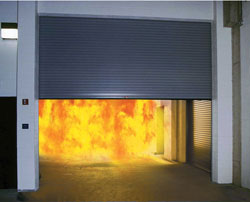Fire Door Inspection, Maintenance and Testing
A HOT TOPIC
Considerations when maintaining Rolling Steel and Sliding Fire Doors
The ROLL of Sliding or Rolling Steel Fire Doors
|
Sliding Fire Doors and Rolling Steel Doors are commonly used in commercial, industrial, and institutional buildings where interior firewalls have been constructed to separate areas within a building in order to contain potential fires within the building spaces. Fire doors can also be used in exterior applications to protect against fire risk from adjacent buildings. Typically, larger openings in firewalls are protected by Fire Rated Rolling Steel Fire doors or Slinding Fire Doors.
Indication of a fire on the premises triggers automatic closing of fire doors to restrict the fire's spread, slow smoke dispersion and reduce oxygen supply to the fire. These benefits provide additional time for people within the structure to escape and aid fire officials in extinguishing the fire. Many buildings, including Commercial and Industrial buildings, health care cacilities, office buildings, retail stores and warehouses are liket to have sliding or rolling fire doors.
|
 |
What can happen if a large opening is covered by a non-fire rated rolling steel door? A large opening covered by a rolling steel door that is not fire rated will not automatically close under fire conditions, allowing an opportunity for fire and burning objects to pass through from one side of the opening to the other and possibly compromising life and property.
Should a fire occur, the health, safety and welfare of the building occupants and emergency responders depend on a proactive, comprehensive fire door preventive maintenance program.
Preventative Maintenance and Annual Fire Door Testing and Recertification
Even with clear Fire Door codes and Standards, building owners and managers continue to neglect inspection and maintenance procedures that can create significant Life Safety Issues.
To insure and protect against the spread of fire and smoke within a building, maintenance and facility managers need to implement a preventive maintenance program for fire doors in accordance with locally adopted codes and national standards (see NFPA 80 Standard for Fire Doors and Other Opening Protectives)
The NFPA claims failure to close is the most common failure mode of fire doors in actual fires. Contributing factors include: lack of maintenance; physical damage to the door, guides, or tracks; and blocked doorways.
Managers cannot ensure reliable fire-door performance unless doorways remain clean and technicians maintain doors in operating condition according to NFPA 80. Also, technicians without delay must make repairs and correct defects that could interfere with operation.
The 2007 edition of the NFPA 80 mandates facilities use only labeled fire doors, and a label must be affixed permanently to the door. Open Fire Doors must be configured for automatic release and closing when fire and smoke conditions occur. NFPA 80, 2010 Revision, calls for qualified fire door inspectors.
Annual Testing and Inspection Requires a Written Record
To minimize failures and improve reliability, NFPA 80 states, “Fire door assemblies shall be inspected and tested not less than annually, and a written record of the inspection shall be signed and kept for inspection by the Authority Having Jurisdiction (AHJ).” NFPA 80, 2010 Revision, calls for qualified fire door inspectors.
Only trained individuals or technicians with knowledge and understanding of the operating components of the Rolling Steel Fire Door or Sliding Fire Door should perform inspection and testing of fire doors for proper function. Before testing, the trained fire door technician should perform a visual inspection to identify damaged or missing parts that could create a hazard during testing and that may affect operation or resetting of the Fire Door Release Mechanism.
Preventing door blockage is critical to minimizing the spread of fire and smoke. Door openings and the surrounding areas must be clear of anything that could obstruct or interfere with the door’s free operation. Clearly marking the floor or surrounding area of a fire door will help prevent the piling of material against sliding fire doors or blocking or wedging rolling steel fire doors in the open position.
Proper maintenance of closing mechanisms is equally important in protecting occupants and visitors.
NFPA 80 mandates the following:
•Self-closing devices must be in working condition.
•Annually inspect and test all horizontal or vertical sliding and rolling fire doors for operation and full closure.
•Reset the release mechanism according to the manufacturer’s instructions.
•Maintain and make available to the AHJ a written record.
•When conducting the annual test for operation and full closure on rolling steel fire doors, perform two drop tests. The first test checks for operation and full closure, and the second test verifies the automatic-closing device has been reset.
•Do not paint fusible links or other heat-actuated devices and release devices.
•Prevent paint from accumulating on movable parts.
In summary, to insure and protect against the spread of fire and smoke within a building that can create significant Life Safety Issues, maintenance and facility managers need to implement Preventative Maintenance and Annual Fire Door Testing and Recertification in accordance with locally adopted codes and national standards.
Click here to see the Wayne Dalton FireStar 700 Series brochure.
Michigan Commercial Door Group can service all of your door and dock needs in Southeastern Michigan, including Detroit, Flint and Ann Arbor. Please call 877-881-6758 to speak with one of our representatives.
|